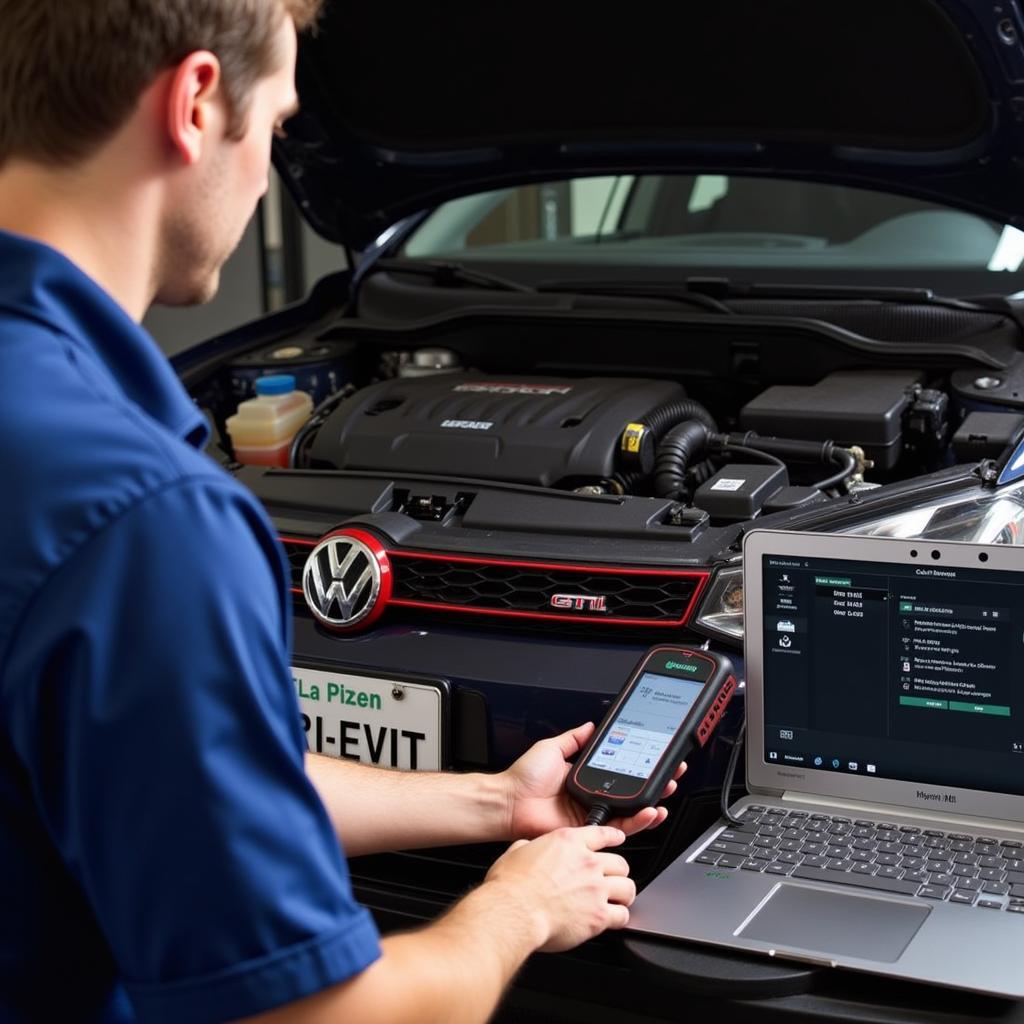An OBDII scanning tool is no longer a luxury reserved for mechanics; it’s rapidly becoming an essential tool for car owners. This powerful device unlocks a treasure trove of information hidden within your vehicle’s computer system, empowering you to diagnose and, in some cases, even fix car problems yourself.
What is an OBDII Scanning Tool?
An OBDII (On-Board Diagnostics II) scanning tool, often referred to as a code reader, is a device that connects to your car’s OBDII port. This port, typically located under the dashboard on the driver’s side, acts as your vehicle’s data hub. The scanning tool communicates with your car’s computer, retrieving diagnostic trouble codes (DTCs) that illuminate the dreaded “Check Engine” light.
Why Do You Need an OBDII Scanning Tool?
For the average car owner, an OBDII scanning tool offers numerous benefits:
- Early Problem Detection: Identify potential issues before they escalate into costly repairs, saving you time and money.
- DIY Diagnostics: Decode those cryptic “Check Engine” lights and gain a clearer understanding of your car’s health.
- Informed Repair Decisions: Armed with DTCs, you can research potential solutions and even negotiate more effectively with mechanics.
- Enhanced Vehicle Monitoring: Track vital engine parameters like fuel efficiency, coolant temperature, and emissions performance.
 Mechanic Using OBDII Scanner
Mechanic Using OBDII Scanner
Types of OBDII Scanning Tools:
Choosing the right OBDII scanning tool can be overwhelming, given the wide range of options available:
1. Basic Code Readers: These entry-level devices retrieve and display DTCs, offering a budget-friendly way to understand basic car problems.
2. Advanced Code Readers: Beyond basic DTC retrieval, these tools offer additional features like code clearing, live data streaming, and manufacturer-specific code definitions.
3. Professional-Grade Scanners: Used by experienced mechanics, these high-end tools offer comprehensive diagnostic capabilities, including bi-directional controls, advanced programming functions, and access to proprietary vehicle systems.
Choosing the Right OBDII Scanning Tool for You:
Consider these factors when selecting an OBDII scanning tool:
- Your Budget: Prices range from affordable basic code readers to feature-rich professional-grade scanners.
- Your Technical Skills: Choose a tool with a user-friendly interface and features that match your level of expertise.
- Vehicle Compatibility: Ensure the scanner supports your car’s make, model, and year.
- Desired Features: Prioritize features like live data streaming, code clearing, and manufacturer-specific code definitions based on your needs.
How to Use an OBDII Scanning Tool:
Using an OBDII scanning tool is generally straightforward:
- Locate the OBDII Port: Usually located under the dashboard on the driver’s side.
- Connect the Scanner: Turn off the ignition and plug the scanner into the OBDII port.
- Turn the Ignition On: Turn the key to the “on” position without starting the engine.
- Read Codes: Follow the scanner’s instructions to read the DTCs stored in your car’s computer.
- Research Codes: Use the internet or a reliable automotive resource to understand the meaning of the codes.
Important Note: While OBDII scanning tools are valuable for diagnosis, some repairs may require professional expertise and specialized equipment.
“An informed car owner is an empowered car owner.” – John Roberts, Senior Automotive Engineer
Investing in an OBDII scanning tool is an investment in your peace of mind and your wallet. It empowers you to take control of your car’s health, allowing you to make informed decisions about maintenance and repairs.
Contact ScanToolUS today at +1 (641) 206-8880 or visit our office located at 1615 S Laramie Ave, Cicero, IL 60804, USA, and let our team of experts guide you to the perfect OBDII scanning tool for your needs.
Frequently Asked Questions:
- Will an OBDII scanning tool work on any car? Most cars manufactured after 1996 in the United States are equipped with the OBDII system, but it’s always best to double-check your vehicle’s compatibility.
- Can I clear the “Check Engine” light with an OBDII scanning tool? Yes, most scanners offer the ability to clear DTCs and reset the “Check Engine” light. However, this doesn’t fix the underlying issue; it merely clears the warning.
- Do I need a professional-grade scanner? For most car owners, a basic or advanced code reader will suffice. Professional-grade scanners are typically reserved for experienced mechanics.
- What are some reliable resources for understanding DTCs? Online automotive forums, repair manuals, and manufacturer websites can provide valuable insights into DTC meanings and potential solutions.
- Can an OBDII scanning tool improve my car’s performance? While not a performance enhancer, a scanner can help you monitor vital engine parameters, allowing you to identify potential issues that may be affecting performance.


